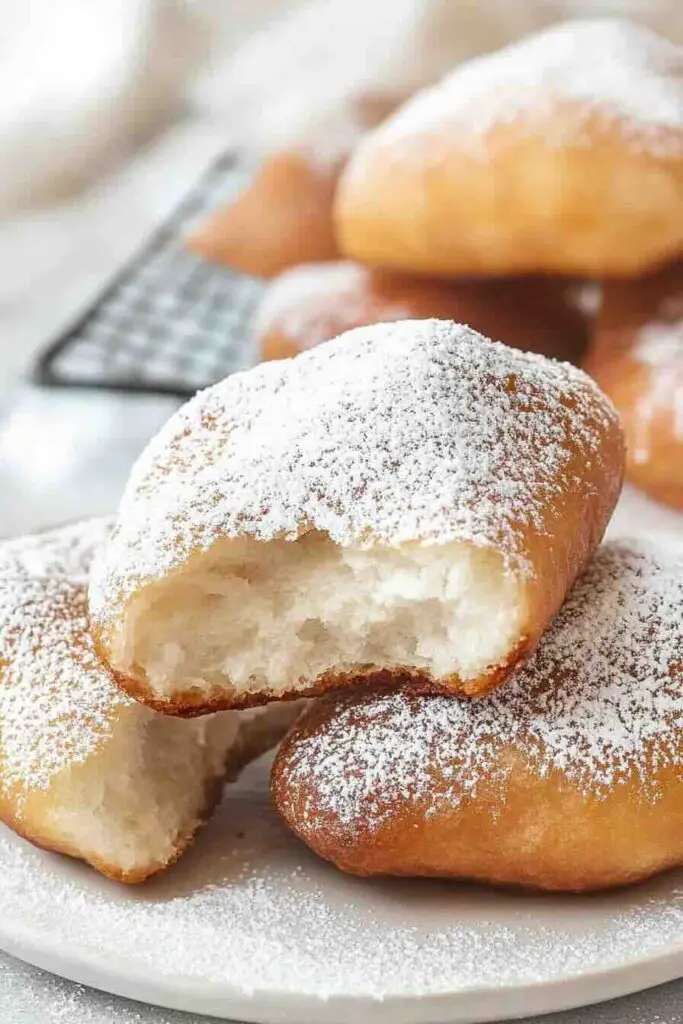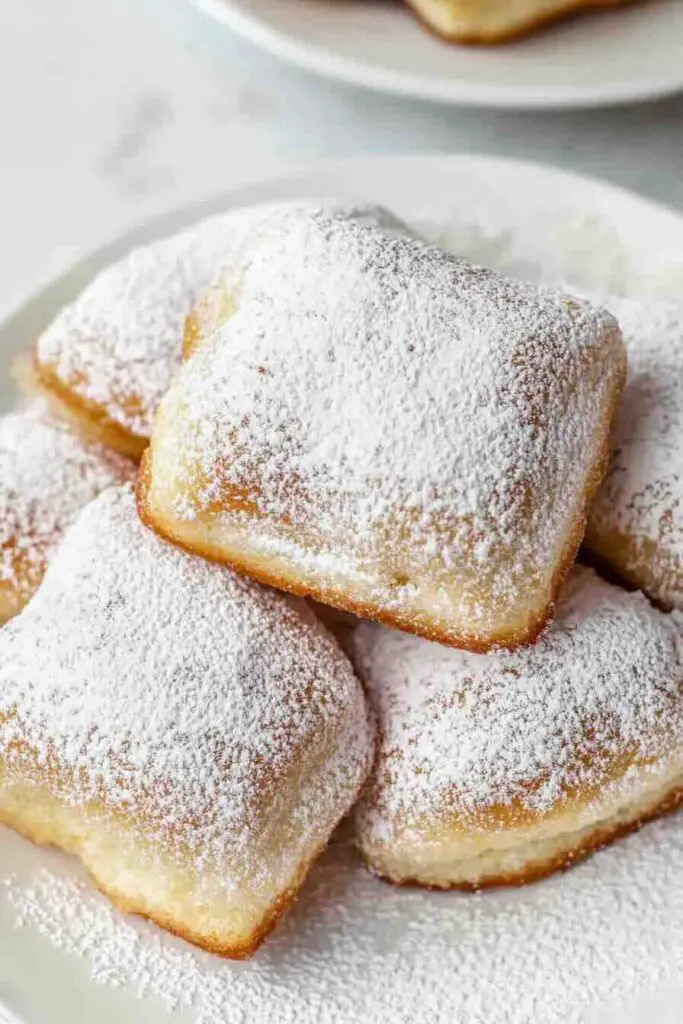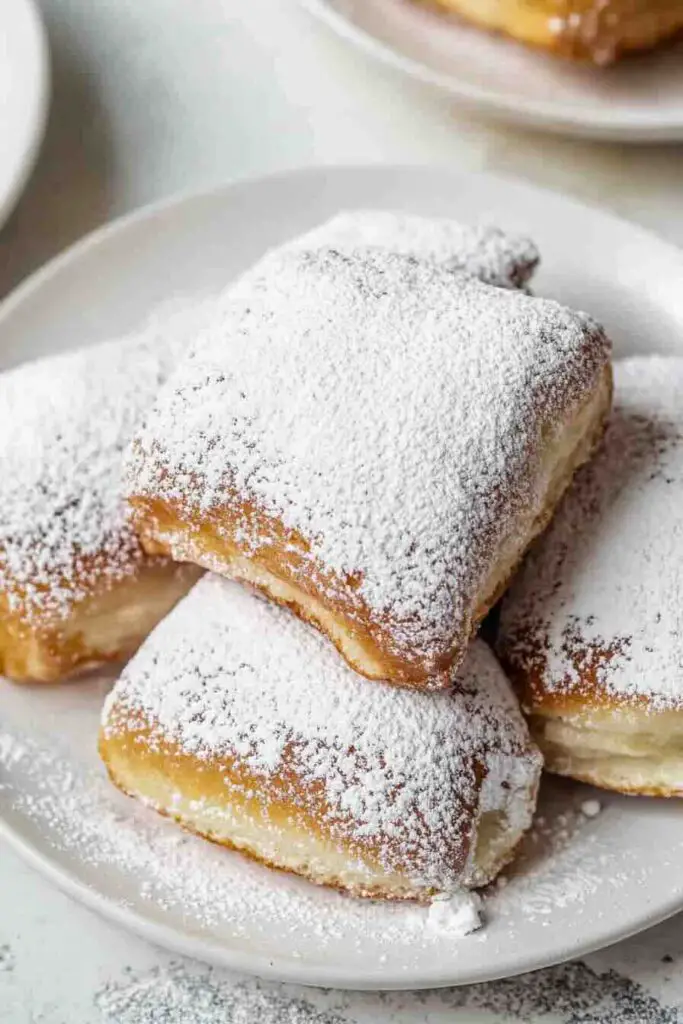Introduction
Beignets. Just the word itself sounds fancy, doesn’t it? But don’t let that fool you—these little squares of fried dough heaven are easier to make than you think! Whether you’ve had them before or this is your first time hearing about them, get ready to fall in love.
My first encounter with beignets? Picture this: a warm morning in New Orleans, a gentle breeze from the Mississippi River, and me, standing in line at Café du Monde, inhaling the scent of freshly fried dough. The moment that pillowy bite hit my taste buds—powdered sugar dusting my fingers and nose—it was game over. I knew I had to learn how to make them at home.
This guide is all about giving you the same magic. We’ll break down everything—history, technique, variations, and pro tips—to make sure your homemade beignets rival the best. So grab your apron, and let’s get frying!

Reasons You’ll Love This Recipe
Easy to Make at Home
If deep-frying scares you, let’s clear that up right now. You don’t need a professional setup—just a pot and a bit of patience. The ingredients? Simple. The process? Foolproof.
Versatile Treat
Beignets aren’t just for breakfast (though, let’s be honest, they’re a dream with coffee). They make a killer dessert, an indulgent snack, or even a fancy brunch addition.
Better Than Store-Bought
Pre-made beignets? No thanks. Freshly fried ones have a crisp exterior, an airy inside, and that melt-in-your-mouth sugar coating that packaged versions just can’t deliver.
Crowd-Pleaser
Make these for friends or family, and watch them disappear faster than you can dust them with sugar. Guaranteed.
Frying & Baking Options
Not into deep-frying? No problem. I’ll show you how to bake or even air-fry these beauties without losing that signature crispness.
What Makes a Good Beignet?
Perfect Texture
A proper beignet should have an airy, slightly chewy interior and a crisp, golden-brown crust. Think of it as a hybrid between a donut and a cloud.
Proper Dough Proofing
Rushing the rise? Big mistake. The dough needs time to develop those gorgeous air pockets. Patience equals fluffiness!
Right Frying Temperature
Too hot, and you get burnt outsides with raw insides. Too cool, and you end up with greasy, heavy dough. Stick to 360°F (182°C), and you’re golden—literally.
Generous Sugar Dusting
Powdered sugar isn’t just a topping—it’s part of the beignet experience. The more, the better.
Pairing with Coffee
Beignets and café au lait? A match made in breakfast heaven. The bitterness of coffee balances the sweetness perfectly.
The Cultural Significance of Beignets
Beignets in French and New Orleans Cuisine
French settlers brought beignets to Louisiana, but New Orleans made them famous. They’re now a staple of Southern hospitality, often enjoyed with live jazz and a good conversation.
History of Beignets
Beignets have been around since the 16th century. French bakers created them as a way to use up extra dough, and when settlers moved to Louisiana, they brought their pastry traditions with them. The beignets we know today evolved in the kitchens of New Orleans, cementing their place in American culinary history.
Ingredients for the Perfect Beignets
Essential Ingredients & Their Roles
- Flour – The foundation of the dough. All-purpose works best.
- Yeast – Gives beignets their signature rise.
- Milk & Egg – Adds richness and a slight chew.
- Sugar – A touch of sweetness and helps activate the yeast.
- Butter – For that melt-in-your-mouth texture.
- Oil for Frying – Use a neutral oil like vegetable or canola.
- Confectioners’ Sugar – The classic finishing touch.
Ingredient Substitutes & Adjustments
- Need a dairy-free version? Swap out milk and butter for non-dairy alternatives.
- Gluten-free? A good 1:1 gluten-free flour blend will do the trick.
Essential Equipment for Making Beignets
- Mixing bowls
- Measuring cups and spoons
- Stand mixer (or elbow grease for hand-kneading)
- Rolling pin
- Pizza cutter or sharp knife
- Deep fryer or heavy-bottomed pot
- Thermometer (to keep oil at 360°F)
- Paper towels and a cooling rack
Step-by-Step Instructions
Making the Dough
- Activate the yeast by combining it with warm water and sugar. Let it sit until foamy.
- Mix in the milk, egg, and melted butter.
- Slowly add flour, stirring until a dough forms.
- Knead until smooth, then let it rise for at least two hours.
Proofing & Rolling the Dough
After the dough has doubled in size, roll it out to about ¼ inch thick. Any thinner, and they’ll be too crispy; any thicker, and they’ll be too doughy.
Cutting & Frying the Beignets
- Cut into 2-inch squares.
- Heat oil to 360°F (182°C).
- Fry in batches, flipping once until golden brown.
- Drain on paper towels before hitting them with powdered sugar.
Baking & Air Fryer Methods
- Baking: 350°F (175°C) for 12-15 minutes.
- Air Frying: 375°F (190°C) for about 8 minutes.
How to Tell When Beignets Are Done
Perfectly cooked beignets have a golden-brown exterior and a hollow, airy interior. They should puff up in the oil, doubling in size, and when tapped lightly, they should sound slightly hollow. Undercooked beignets will be dense and doughy in the center, while overcooked ones will be too crisp and lack that pillowy softness inside.
To check for doneness, cut one open while frying your first batch. If the inside is still raw, lower the heat slightly and give them a few more seconds per side. Once you get the timing right, you’ll be on your way to a batch of flawless beignets.

Variations & Toppings
Beignets may be traditionally dusted with a heavy snowfall of powdered sugar, but why stop there? There’s a whole world of flavors waiting to be explored! If you love a bit of warmth and spice, a cinnamon-sugar coating can take your beignets to a whole new level. Instead of just dusting them with plain sugar, mix ground cinnamon with granulated sugar and roll the warm beignets in the mixture. The heat helps the sugar stick, creating a sweet, slightly spicy crunch on the outside while keeping the inside perfectly soft.
For chocolate lovers, a drizzle of melted chocolate—whether dark, milk, or even white—adds a rich, indulgent twist. Want something extra fancy? Try making a chocolate ganache by heating heavy cream and mixing it with finely chopped chocolate until smooth. Drizzle it generously over the beignets or serve it on the side as a dipping sauce.
Savory beignets might not be as well-known, but they’re just as delightful. Instead of a sweet filling, try adding cheese to the dough or stuffing them with creamy ricotta, herbed cream cheese, or even a spiced meat mixture. A sprinkle of garlic powder or parmesan on top after frying can turn them into an irresistible appetizer. The contrast between the crispy, golden dough and the salty, cheesy interior is a game-changer.
Nutritional Insights
Beignets may not be a “health food,” but let’s be real—sometimes, indulgence is worth every calorie. A classic beignet typically contains around 134 calories, depending on its size and how much powdered sugar is added. Most of those calories come from carbohydrates and fats, with a small amount of protein from the eggs and milk in the dough.
If you’re looking for ways to make them a little lighter, you have options! Baking instead of frying is one of the easiest modifications. While the texture will be slightly different—less crispy but still soft and pillowy—it cuts down on the oil absorption significantly. Another way to lighten things up is by reducing the sugar in the dough. Beignets rely on their powdered sugar topping for sweetness, so cutting back on the sugar in the batter won’t affect the flavor much.
And, if you’re really into the idea of a guilt-free treat, why not try using alternative sweeteners? Monk fruit sweetener, stevia, or coconut sugar can be used in place of white sugar. While they won’t replicate the exact flavor, they can help make beignets a little more diet-friendly without losing their charm.
Pro Tips & Tricks
Making perfect beignets requires a bit of technique, but once you get the hang of it, you’ll wonder why you didn’t try sooner. The first rule? Don’t rush the dough! Yeast-based dough needs time to rise properly, so if you’re impatient and cut the proofing time short, you’ll end up with dense, chewy beignets instead of light and airy ones. Ideally, let the dough rise in a warm, draft-free area until it doubles in size.
When rolling out your dough, thickness matters. Too thin, and your beignets won’t puff up properly. Too thick, and they’ll be doughy in the center. The sweet spot? About ¼ inch thick before cutting into squares.
Frying temperature is another critical factor. The oil should be kept at a steady 360°F (182°C). If it’s too hot, the outside of the beignets will burn before the inside is fully cooked. Too cool, and the dough will absorb excess oil, making them greasy instead of crisp. A good trick is to test the oil with a small piece of dough—if it sizzles immediately and floats to the top, you’re good to go.
Powdered sugar application is another art form. The key is to dust them while they’re still warm so the sugar sticks properly. If you want an extra-thick coating (because why not?), give them one layer of sugar, wait a minute, then dust them again.
Lastly, if you’re making beignets ahead of time, don’t stack them while they’re still warm. This traps steam, making them soggy. Instead, arrange them in a single layer on a cooling rack until they’ve cooled slightly. That way, they’ll stay crisp and perfect for longer.
My Take on Beignets
There’s something undeniably special about homemade beignets. Every time I make them, I get transported back to my first visit to New Orleans, standing in the bustling Café du Monde, powdered sugar flying everywhere as I took that first glorious bite. Since then, I’ve made them dozens of times, tweaking and testing different variations, but one thing never changes—beignets always bring joy.
My personal favorite way to enjoy them? Fresh out of the fryer, still hot, with an almost absurd amount of powdered sugar piled on top. And if I’m feeling extra indulgent, I’ll whip up a side of dark chocolate ganache for dipping. The contrast between the warm, airy dough and the rich, velvety chocolate? Pure bliss.
Beignets are also my go-to for impressing guests. Whether it’s a weekend brunch or a cozy evening dessert, they never fail to get that wide-eyed, “Oh WOW” reaction. Trust me—once you serve up a batch of homemade beignets, you’ll instantly be everyone’s favorite person.
Storage & Health Tips
Beignets are best eaten fresh, but if you somehow end up with leftovers (a rare occurrence, let’s be honest), proper storage is key. They can be kept at room temperature in an airtight container for up to two days. However, they will lose their crispiness over time.
For longer storage, freezing is a great option. Just let them cool completely before placing them in a freezer-safe bag. When you’re ready to eat them, pop them in a 350°F (175°C) oven for a few minutes to restore their warmth and slight crispiness.
Reheating is important—microwaving will soften them, but they won’t have that freshly fried texture. If you want to revive them properly, the oven or air fryer is your best bet.

FAQs
What is the difference between a doughnut and a beignet?
Doughnuts are usually round and can be either cake-based or yeast-based, while beignets are square, always yeast-based, and traditionally covered in powdered sugar.
Are beignets French or New Orleans?
They originated in France but became famous in New Orleans, where they took on their signature form.
Are beignets just funnel cake?
Nope! Funnel cake is made from a batter, poured into hot oil in a lacy pattern. Beignets use a yeast dough, making them thicker, airier, and chewier.
What do beignets taste like?
They taste like a cross between a light, fluffy doughnut and a crisp, buttery pastry, with a delicate sweetness from the powdered sugar.
Before You Go…
Craving more goodness? Check out my recipe for Madeleine next. It’s just as comforting, indulgent, and easy to make. You’re going to love it! ❤️
Print
Beignets
- Prep Time: 15 minutes
- Cook Time: 10 minutes
- Total Time: 2 hours 25 minutes (including rising time)
- Yield: 24 beignets 1x
Description
Soft, pillowy, and covered in a generous dusting of powdered sugar, beignets are the ultimate treat! Whether you’ve had them in New Orleans or are trying them for the first time, this easy homemade beignets recipe will bring that iconic café experience right to your kitchen. Perfect for breakfast, dessert, or a sweet afternoon snack, these golden-fried pastries are irresistibly delicious.
Ingredients
Dough:
- 3 ½ cups all-purpose flour
- 2 ¼ teaspoons active dry yeast (1 packet)
- ¾ cup warm milk (about 110°F)
- ¼ cup granulated sugar
- 1 large egg
- 2 tablespoons unsalted butter, melted
- ½ teaspoon salt
- ½ teaspoon vanilla extract
For Frying & Topping:
- 3 cups vegetable oil (for frying)
- 1 cup powdered sugar (for dusting)
Instructions
- Activate the Yeast: In a small bowl, mix warm milk, sugar, and yeast. Let sit for 5–10 minutes until foamy.
- Make the Dough: In a large bowl, combine flour and salt. Add the yeast mixture, egg, melted butter, and vanilla. Mix until a dough forms.
- Knead & Rise: Knead for 8–10 minutes until smooth. Cover and let rise in a warm place for 1–2 hours, or until doubled in size.
- Roll & Cut: Roll dough to about ¼-inch thickness on a floured surface. Cut into 2-inch squares.
- Fry to Perfection: Heat oil to 360°F (182°C). Fry a few pieces at a time, flipping until golden brown, about 30–60 seconds per side. Drain on paper towels.
- Dust & Serve: Generously coat warm beignets with powdered sugar. Serve immediately and enjoy!
Notes
- Make Ahead: Dough can be prepared a day in advance and stored in the fridge.
- Baking Option: Bake at 350°F for 12–15 minutes for a lighter version.
- Flavor Twists: Try cinnamon sugar, chocolate drizzle, or stuffed beignets with fruit jam.
Nutrition
- Calories: 134
- Sugar: 5g
- Sodium: 65mg
- Fat: 6g
- Saturated Fat: 2g
- Carbohydrates: 18g
- Protein: 2g
- Cholesterol: 10mg
